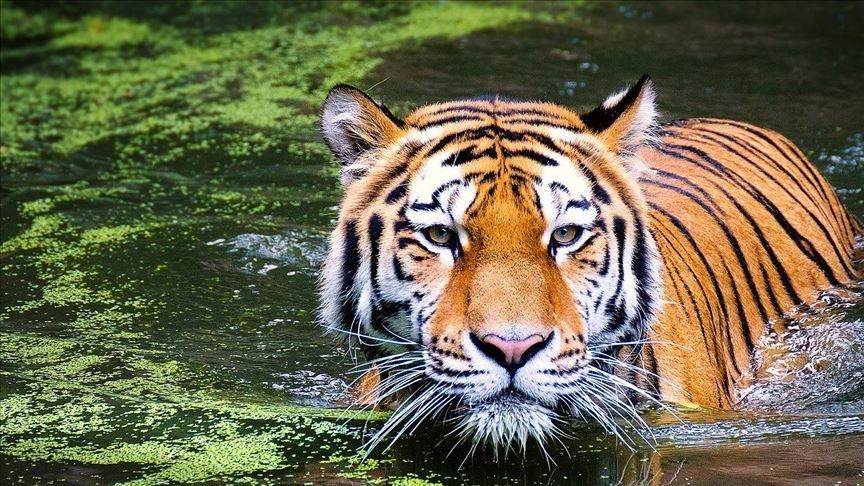‘Tiger population in India still fewer than potential’
On eve of World Tiger Day, India's wildlife expert says country’s habitat can host 15,000 tigers against the current 3,000

NEW DELHI
Although India currently hosts the largest tiger population, experts believe that the country has not achieved much progress over the years in protecting and increasing its numbers.
Supporting dark vertical stripes on orange-brown fur with a lighter underside and once ranged widely from the Eastern Anatolia in the west to the Amur River basin in the east, and in the south from the foothills of the Himalayas, the tiger is now listed as endangered on the International Union for Conservation of Nature (IUCN) list.
Speaking exclusively to Anadolu Agency, on eve of World Tiger Day, which is being observed on Thursday K. Ullas Karanth, director of Centre for Wildlife Studies based in the southern Indian city of Bangalore said the country has not achieved much because of not following the scientific policies.
"We had about 2,000 tigers 50 years ago and have about 3,000 now. Given the potential habitat of over 300,000 square kilometers, which has a potential to host 15,000 tigers, I would say we have not achieved much," he said.
As per official estimates, India last year counted 2,967 tigers in its forests against 2,226 recorded in 2014.
The government is running Project Tiger which undertakes research and converses the habitat of this largest wild cat species, which is also the national animal of India.
Karanth said that Indian tiger recovery efforts began over 50 years ago, and the country has done relatively better than other countries in terms of releasing funds, enforcing conservation laws, and creating public interest in tigers.
"However, because we have failed to base our policies on sound science and the stranglehold of excessive bureaucracy, we have not achieved what is possible," he said.
Karanth, who has conducted pioneering research on the ecology of tigers, sympatric predators, and other large mammals said that rapid urbanization is not the main cause of tiger habitat shrinkage.
Problems vary
"Urbanization and a desire of the rural people to migrate to semi-urban and urban areas is reducing pressure on tiger forests. The problems are different, and vary among regions of the country," he said.
He said the most extensive forests of central and eastern India, "illegal hunting of prey and tigers is the main problem”.
"Forest exploitation and cattle grazing by local people is also laying waste on large tracts. Infrastructure projects such as roads and railways are breaking up habitat connectivity," he said.
Karanth further said that inefficient green energy projects, such as micro-hydel projects and rural road projects are also increasingly opening tiger habitats to negative human impacts.
Asked if India is doing enough to cooperate with neighboring countries to preserve tigers since the animal does not know borders, Karanth said this largest wild cat has been wiped out on both sides of the border along, more so along the China-Myanmar region.
"The border where we share tiger habitats are with Myanmar, China-Tibet, Bhutan, Bangladesh, and Nepal...my impression is there is reasonable coordination with Nepal, Bhutan, and Bangladesh which are countries that share tiger populations with India," he said.
Man-animal conflict
About increasing man-animal conflict, Karanth said "a few well-protected tiger habitats are producing surplus tigers" which are dispersing away and coming into conflict with humans.
"In such situations, the priority should be to quickly kill the problem tigers if human lives are being lost through persistent predation. If not, local hostility will be unmanageable," he said.
Commenting on India's success, as a signatory of St. Petersburg's declaration on tiger conservation, which aims to double the number of tigers across their global range by 2022, the experts said "these summits are just a show and grandstanding for politicians and bureaucrats both national and international”.
"The goal posts for the so called doubling are moved periodically. In the 2000 census the number was 4,000 and in 2004 it was deliberately brought down to 1,400 so that officials can play these games. The real number is most likely to have been around 3,000 for the past two decades. Use of poor methods and hiding the data from independent scrutiny are how things are being done," he said.
Indian Prime Minister Narendra Modi had claimed that the country has completed this target of doubling the tiger population in 2019, four years ahead of the deadline.
Anadolu Agency website contains only a portion of the news stories offered to subscribers in the AA News Broadcasting System (HAS), and in summarized form. Please contact us for subscription options.







